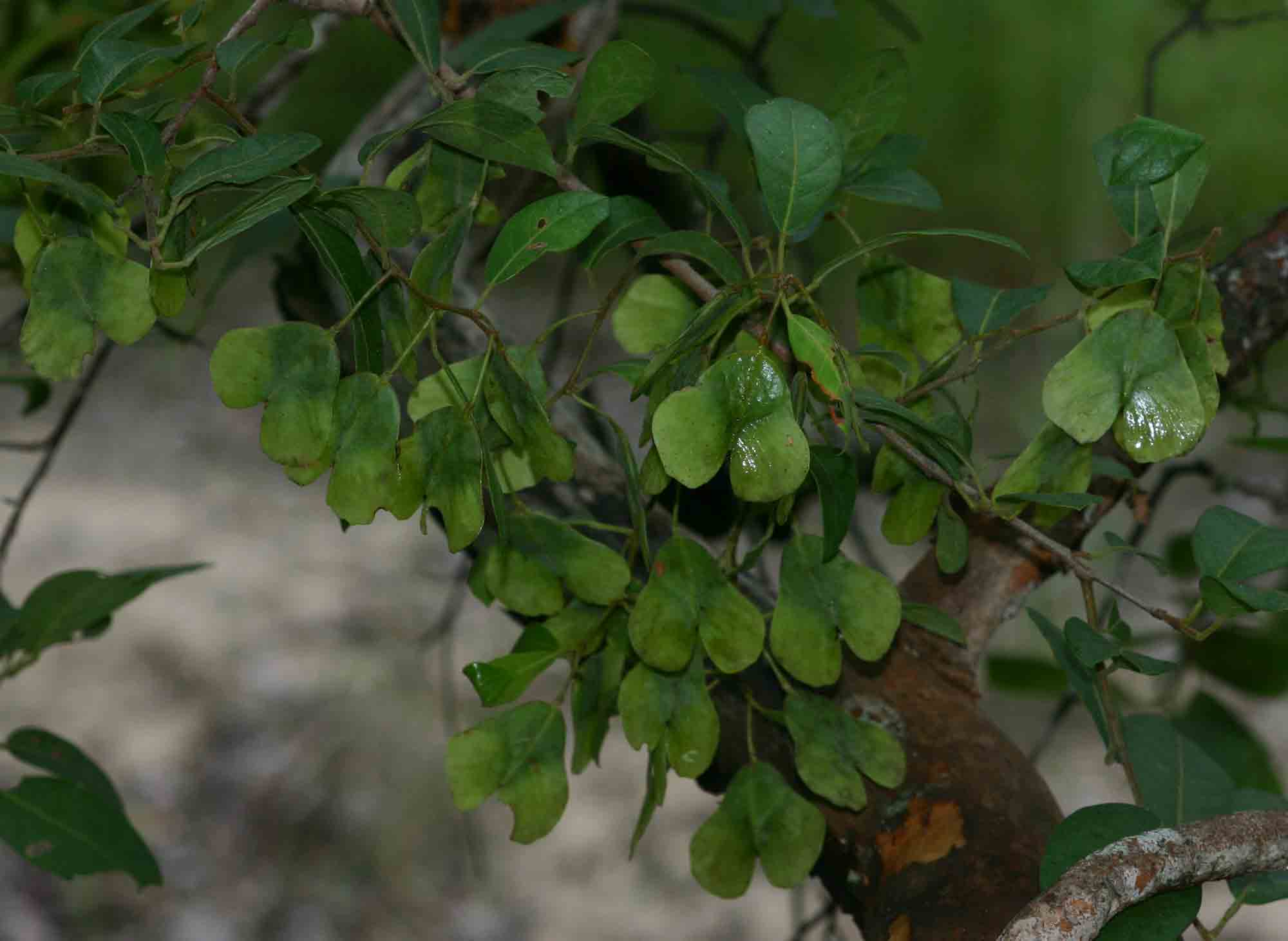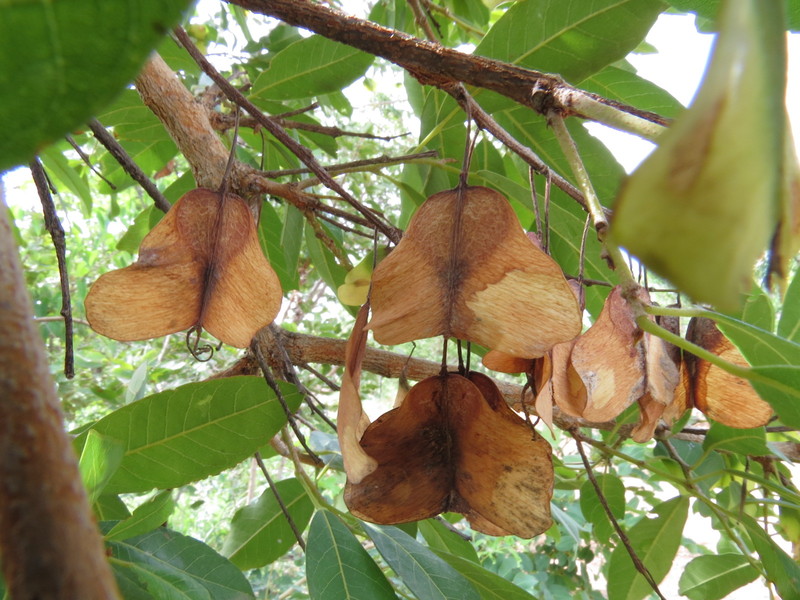Hymenocardia acida Tul
| Botanical Name | Hymenocardia acida Tul |
| Order: | Malpighiales |
| Family: | Phyllanthaceae |
| Genus: | Hymenocardia |
| Species: | H. acida |
| Common Names: | French digbé (Bouquiaux); coeurs-volants (Bailleul). |
Plant Synonyms
Plant Local Names
Hausa Name: Jan itshe
Yoruba Name: Orupa
Plant Habitat
Savannah
Plant Material of Interest
Plant Description
A tree to about 6 m high, gnarled and twisted with characteristic rough rusty-red bark, of the wooded savanna thoughout the Region from Senegal to W Cameroons, and widespread in tropical Africa.The wood is light brown or pink, darkening to orange, close-grained, with conspicuous annual rings, and hard (12, 20, 21). It has been said to be brittle and good only for firewood (12, 39). This may be reflected in certain Ivorean names meaning The tree which kills the wife’, i.e. when an unfaithful wife goes to collect some firewood, the tree shatters at her touch and a branch pierces her abdomen (27). The Gbaya of the Central African Republic recognise the tree as producing good firewood; indeed they classify it as ‘woman’s firewood’ being good for the hearth and cooking place, long-lasting while the housewife is about other chores, yet reviving quickly from sleeping embers, with a hot flame and little smoke (47). The tree is used for house-posts in S Nigeria (38), and in Gabon where the wood is made into charcoal for blacksmith’s work (40). In Kenya (11) and in Uganda (14) the wood is known for its hardness, denseness, durability and good resistance to termite-attack. It is used to make pestles and bark-cloth mallets. Charcoal made from the branches is powdered and rubbed on the head for headache in the soudanian region (5).The foliage is browsed a little by cattle in Senegal (1). Young leafy shoots and the fruits may be eaten in Senegal as a supplementary food (19) and in Nigeria (18). Leaves and leafy shoots have a considerable medicinal use. When chewed they have an acid taste. Leaves are prepared into an infusion for use in Senegal for chest-complaints and small-pox and, with the roots, for deficiency diseases (22, 26). A macerate is given for gripe (24), and leaf-decoction used as an eyewash (24, 26). A decoction with honey is taken in Guinea for biliousness (30). In Ivory Coast-Upper Volta a leaf-decoction is used in baths and draughts as a febrifuge, and leaf-powder is taken as snuff for headache or applied topically for rheumatic pains and toothache, or for the same purposes leaves may be pulped with an organic acidic substance such as citron juice or sap of Piliostigma reticulatum (Leguminosae: Caesalpinioideae) (27). Leaf-sap is used in Ivory Coast by installation in ears for otitis, eyes for ophthalmias and nose for headache, and by topical frictions for fever and rheumatic pains (8); or the dried and powdered young leaves may be sprinkled over sores after washing, and a leaf-decoction taken for stomach-ache or used as an eye-wash for conjunctivitis (3). In Tanganyika the leaves are chewed against cough and for ‘swollen’ tummy (36) and for serious stomach-ache (37), and the leaf-sap is squeezed into the infected eyes of children (34).The bark is the source of a brownish red dye which is used in Gabon (40) on raphia work, and perhaps elsewhere in central Africa (15). The bark also contains tannin which is used in central Africa for tanning (12, 15). Concentration in Katanga-grown material has been reported to be 12% (27). Tannins are present also in the leaves and roots (7). Traces of alkaloid have been detected in stem-bark and leaves of Nigerian material but not in the roots (2, 26) and the alkaloid hymenocardine in the root-bark (43).The bark has numerous medicinal uses. When chewed it is bitter and slightly astringent. It produces a copious salivation (22, 26, 31). It is chewed with kola in Sierra Leone for dysentery (13). An aqueous decoction is widely used for pulmonary affections in Senegal (22, 26) and in Guinea (30). In Kordofan a bark infusion, or of the fruit, is made into a boiling inhalation for breathing difficulty (47). It is also deemed good for colds (5). In Senegal powdered bark is added to food for an affection known as pidal (Fula-Fouladou) the symptoms of which are a piercing pain in the shoulders with spasmodic coughing, emaciation and sometimes dermatitis (24, 26). The Tenda compound the bark with that of Zanha golungensis Hiern (Sapindaceae) to make a poultice, covered with leaves of Terminalia macroptera Guill. & Perr. (Combretaceae), and changed daily for application to fractures (44). Powdered bark is taken in The Gambia for abdominal pains (33); for menstrual pains in Tanganyika (34); with palm-oil and rock salt for bloody vomit in Congo (Brazzaville) (6); for painful swellings and debility, and in baths and draughts for epileptic fits in Casamance (23); and against colic and in poultices on abscesses and tumours in Nigeria (4) and in Ubangi (31). The pulped bark is used in Congo (Brazzaville) to treat diarrhoea and dysentery, sterility and dysmenorrhoea of women, and cough; a bark-decoction is used to wash sores and to relieve ophthalmia and migraine, and pulped bark is applied to dermal infections such as parasites, itch, prickly-heat and leprosy (6). The inner bark is powdered and put on ulcers in Zambia (42), and in Tanganyika powdered bark with copper (or gold) filings is sprinkled on syphilitic chancres (16). Water in which the roots have been boiled is considered febrifugal in Nigeria (4) and in N Ashanti, Ghana (9). In NW Nigeria, Salka people use the plant (part not known) in medicine for children with fever (45). Root-bark is eaten with porridge in Tanganyika for malaria (16), and the plant (part not specified) is used in Mozambique for trypanosomiasis (28).Bark and leaves are prescribed together in various ways. In N Nigeria they enter into a complex prescription to give strength on a journey (12), and in Ivory Coast-Upper Volta a preparation is used in baths and lotions to strengthen debilitated children, and in draught to relieve dysenteriform diarrhoea (27). A decoction is prescribed in Senegal for a treatment lasting 1–2 months for refractory cough and tuberculosis (24) and for deficiency oedemas (23).The root is used in Senegal to make a mouth-wash for toothache which is said to give good results with treating stomatitis and pyorrhoea also (24). Sap from the roots is applied topically in Congo (Brazzaville) for earache and tooth-troubles (6). In southern Africa steam-inhalations from the root-powder is considered anti-enteralgic and cleansing. It is given in Senegal as a precursor of treatment for sterility, and can also be given safely during pregnancy (24, 26). In Tanganyika water in which roots have been soaked is considered a good medicine to give women during pregnancy (29). A root-decoction and leaf-sap is taken to prevent miscarriage (16), and powdered root is added to porridge for mothers whose breast-milk is ‘too heavy’ (35). In Ivory Coast the plant is used as a galactogogue, aphrodisiac and anti-dysenteric (8, 27). A root-decoction with leaf-sap is also an anti-dysenteric medicine in Tanganyika (16), and root and stem-barks are used in Ubangi as an emetic antidote to ordeal-poison (31).Root-extracts have shown some insecticidal activity (17).The fruit is edible and is sometimes eaten (10, 20). The ripe fruit is used in Zambia to cure deafness (32).Tenda hunters consider it a hunter’s charm (44).
Plant Used Parts
Plant Uses
i. An infusion of the bark and leaves is regarded as an excellent medicine for the respiratory passages.
ii. A decoction of the leaves, mixed with honey, is given in biliousness
iii. A decoction of the root is used as a febrifuge in Ashanti.
iv. The bark is sometimes used for tanning (Ogbochukwu, 2005).

